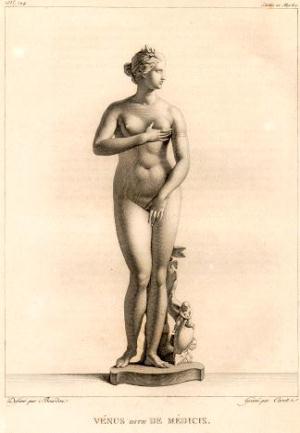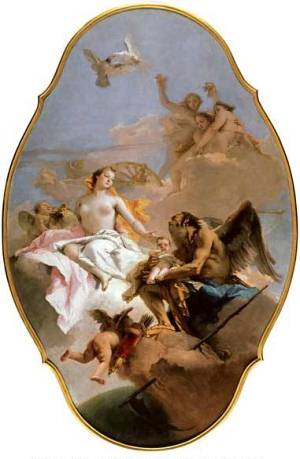
Venus
the goddess of love among the Romans, and more especially of sensual love. Previously to her identification with the Greek Aphrodite, she was one of the least important divinities in the religion of the Romans, and it is observed by the ancients themselves, that her name was not mentioned in any of the documents relating to the kingly period of Roman history. (Saturnalia by Macrobius i. 12.)

Fresco from Pompei, Casa dei Venus, 1st century CE.
This is further evident from the fact that at no time a festival was celebrated in honour of Venus, for the Vinalia (on the 23d of April and 19th of August) were quite a different festival, and were connected with this goddess only by a misinterpretation of the name (Diet, of Ant. s. v. Vinalia), which led courtesans to regard the 23d of April as a holiday of their own, and to worship the goddess on that day in their peculiar way in a temple outside the city. (Fasti By Ovid)
In later times several other solemnities were celebrated to Venus in the month of April partly because that month being the beginning of spring, was thought to be particularly sacred to the goddess of love, and partly because the belief had gradually gained ground that Venus, as the beloved of Mars, was concerned in the origin of the Roman people.

THE VENUS DE’ MEDICI.
The Venus of the Medici is so called from its having been in the possession of the princes of that name in Rome when it first attracted attention, about two hundred years ago. An inscription on the base records it to be the work of Cleomenes, an Athenian sculptor of 200 B.C., but the authenticity of the inscription is doubtful. There is a story that the artist was employed by public authority to make a statue exhibiting the perfection of female beauty, and to aid him in his task the most perfect forms the city could supply were furnished him for models. It is this which Thomson alludes to in his “Summer”:
“So stands the statue that enchants the world;
So bending tries to veil the matchless boast,
The mingled beauties of exulting Greece.”
Byron also alludes to this statue. Speaking of the Florence Museum, he says:
“There, too, the goddess loves in stone, and fills
The air around with beauty;” etc.
And in the next stanza, “Blood, pulse, and breast confirm the Dardan shepherd’s prize.”
This latter point gained support from the legend which made Aeneas a son of Anchises and Aphrodite (identified with Venus. There was at Lavinium a sanctuary of Venus common to all Latium, the ceremonies at which were performed by the people of Ardea, but its age cannot be defined. (Strab. p. 232.) At Rome we may notice the following circumstances as proving the worship of Venus to have been established there at an early time.
There was a stone chapel with an image of Venus Murtea or Murcia in the Circus near to the spot where the altar of Census was concealed.
The surname Murtea or Murcia shows that the myrtle-tree stood in some relation to the goddess, and it is actually said that in ancient times there was a myrtle grove in front of her sanctuary below the Aventine.
It must however be observed that some of the ecclesiastical writers preferred taking the surname Murcia in the sense of "stupid" or "dull" (from murcus).
Another ancient surname of Venus was Cloacina, which, according to Lactantius (i. 20), was derived from the fact that her image was found in the great sewer (cloaca), and was set up by the Sabine king, T. Tatius, in a temple near the forum.
If Venus had been one of the divinities of the lower world, this story might be intelligible enough, but as such was not the case, it appears to be nothing but an etymological inference from the name.
Cloaca is connected with cluere, Cluilia, Cloelia, lucre and there is a tradition that Tatius and Romulus, after the war which had arisen out of the rape of the Sabine women, ordered their subjects to purify themselves before the image of Venus Cluacina. (Plin. H. N. xv. 29 ; comp. Servius, Scholiast on Virgil's Aeneid. i. 724, where purgare must be read for pugnare.}
This explanation agrees perfectly with the belief of the ancients that T. Tatius was the founder of marriage; and Venus Cloacina, accordingly, is the goddess presiding over and purifying the sexual intercourse in marriage.

"An Allegory with Venus and Time"
Giovanni Battista Tiepolo
(1754-8), National Gallery, London
A third ancient surname of the goddess is Calva, under which she had two temples in the neighbourhood of the Capitol. Some believed that one of them had been built by Ancus Marcius, because his wife was in danger of losing her hair; others thought that it was a monument of a patriotic act of the Roman women, who during the siege of the Gauls cut off their hair and gave it to the men to make strings for their bows, and others again to the fancies and caprices of lovers, calvere signifying "to teaze." (Servius, Scholiast on Virgil's Aeneid. Nonius, p. 6.) But it probably refers to the fact that on her wedding day the bride, either actually or symbolically, cut off a lock of hair to sacrifice it to Venus. (Pers. Sat. ii. 70, with the Schol.)
In these, the most ancient surnames of Venus, we must recognise her primitive character and attributes. In later times her worship became much more extended, and the identification with the Greek Aphrodite introduced various new attributes.
At the beginning of the second Punic war, the worship of Venus Erycina or Erucina was introduced from Sicily, and a temple was dedicated to her on the Capitol, to which subsequently another was added outside the Colline gate.
In the year b.c. 114, a Vestal virgin was killed by lightning, and her body was found naked; as the general moral corruption, especially among the Vestals, was believed to be the cause of this disaster, the Sibylline books were consulted which contained the order to build a temple of Venus Verticordia (the goddess who turns the hearts of men) on the via Salaria. (Fasti By Ovid)
After the close of the Samnite war, Fabius Gurges founded the worship of Venus Obsequens and Postvota; Scipio Africanus the younger that of Venus Genitrix, in which he was afterwards followed by Caesar, who added that of Venus Victrix.
The antiquity of the worship of Venus Militaris, Barbata and Equestris is unknown (Serv. L c. ; Macrob. Sat. iii. 8); but the sanctuaries of Venus Rhamnusia, Placida, and Alma are all of a very late date.
Lastly, we may remark, that Venus is also said to have presided over gardens.
From Smith's Dictionary of Greek and Roman Biography and MythologyFrom Herodotus The History. The First Book: Clio
After this they marched forward with the design of invading Egypt. When they had reached Palestine, however, Psammetichus the Egyptian king met them with gifts and prayers, and prevailed on them to advance no further. On their return, passing through Ascalon, a city of Syria, the greater part of them went their way without doing any damage; but some few who lagged behind pillaged the temple of Celestial Venus. I have inquired and find that the temple at Ascalon is the most ancient of all the temples to this goddess; for the one in Cyprus, as the Cyprians themselves admit, was built in imitation of it; and that in Cythera was erected by the Phoenicians, who belong to this part of Syria. The Scythians who plundered the temple were punished by the goddess with the female sickness, which still attaches to their posterity. They themselves confess that they are afflicted with the disease for this reason, and travellers who visit Scythia can see what sort of a disease it is. Those who suffer from it are called Enarees.
From Roman Antiquities and Ancient Mythology
Romulus divided the year into ten months; the first of which was called March from Mars, his supposed father; the 2d April, either from the Greek name of Venus, (Aφροδιτα) or because trees and flowers open their buds, during that month; the 3d, May, from Maia, the mother of Mercury; the 4th, June, from the goddess Juno; 5th, July, from Julius Cæsar; 6th, August, from Augustus Cæsar; the rest were called from their number, September, October, November, December.
From Mithraism and the Religions of the Empire by Franz Cumont
When, under the empire, the taurobolium was introduced into Italy, it was not quite certain at the outset what Latin name should be given the goddess in whose honor it was celebrated. Some saw in her a celestial Venus; others compared her to Minerva, because of her warlike character. But the priests of Cybele soon introduced the ceremony into their liturgy,--evidently with the complicity of the official authorities, for nothing in the ritual of this recognized cult could be modified without the authorization of the quindecemvirs.
